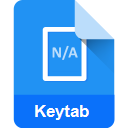.KEYTAB File Extension

Kerberos Keytab File
| Developer | MIT |
| Popularity | |
| Category | Data Files |
| Format | .KEYTAB |
| Cross Platform | Update Soon |
What is an KEYTAB file?
The .KEYTAB file extension is associated with Kerberos, a network authentication protocol designed to provide strong authentication for client/server applications. The Keytab file contains pairs of Kerberos principals and encrypted keys, allowing systems to authenticate to each other without requiring the user to enter a password.
More Information.
The Keytab file was initially designed to facilitate secure authentication between client and server applications within a Kerberos realm. It stores the long-term keys of principals (users or services) in a encrypted form, allowing systems to authenticate without the need to transmit passwords over the network.
Origin Of This File.
The .KEYTAB file format originates from the Kerberos protocol, which was developed by MIT in the 1980s. It was created to address the limitations of password-based authentication and provide a more secure method for authenticating users and services in a networked environment.
File Structure Technical Specification.
A .KEYTAB file typically consists of multiple entries, each representing a principal and its associated encrypted keys. These keys are derived from the Kerberos authentication process and are used for secure communication between entities within the Kerberos realm.
The structure of a .KEYTAB file may vary depending on the implementation of Kerberos, but it generally includes information such as the principal name, key version number, key encryption type, and the encrypted key itself.
How to Convert the File?
Windows:
Converting a .KEYTAB file in Windows typically involves using Kerberos-aware applications or utilities capable of interpreting Kerberos authentication.
Here are general steps to convert the file:
- Using Kerberos Utilities: Windows provides utilities like ktpass.exe, which allows you to generate a .KEYTAB file from a keytab entry. You can use Command Prompt or PowerShell to run this utility with appropriate parameters to convert the file.
- Third-Party Tools: There are third-party applications available for Windows that support Kerberos authentication and may offer features for managing .KEYTAB files. These tools often provide graphical interfaces for easier conversion and management.
- Configuration Tools: Some server management or configuration tools for Windows Server environments may include features for handling .KEYTAB files. These tools streamline the process of configuring Kerberos authentication and managing keytab entries.
Linux:
Converting a .KEYTAB file in Linux can be done using built-in command-line tools or third-party utilities.
Here’s how to do it:
- Using ktutil: Linux systems often come with the ktutil command-line utility, which allows you to manage keytab files. You can use ktutil to add, remove, or modify entries in the keytab file, effectively converting it to meet your requirements.
- Custom Scripts: You can write custom scripts using programming languages like Bash or Python to manipulate .KEYTAB files as needed. These scripts can automate tasks such as extracting keys or generating new keytab files from scratch.
- Third-Party Utilities: There may be third-party tools available for Linux that offer additional features for managing Kerberos authentication and keytab files. These tools may provide a more user-friendly interface compared to command-line utilities.
Mac:
On macOS, converting a .KEYTAB file can be achieved using similar methods as on Linux, leveraging built-in tools or third-party utilities.
Here’s how you can do it:
- Using ktutil: macOS, being Unix-based, includes the ktutil command-line utility, which allows you to manipulate keytab files. You can use ktutil to convert, add, or remove entries in the .KEYTAB file as needed.
- Third-Party Applications: There might be macOS applications available that offer graphical interfaces for managing Kerberos authentication and keytab files. These applications may provide a more intuitive way to convert .KEYTAB files compared to command-line tools.
Android and iOS:
Converting .KEYTAB files on mobile platforms like Android and iOS is less common due to the limited support for Kerberos authentication and keytab management.
However, if necessary, you might be able to achieve this using the following methods:
- Custom Applications: Develop custom mobile applications that handle Kerberos authentication and keytab file management. These applications would need to integrate Kerberos libraries and provide a user interface for converting .KEYTAB files.
- Server-Side Conversion: Perform the conversion on a server or desktop system and then transfer the converted file to the Android or iOS device. This could involve using one of the previously mentioned methods for Windows, Linux, or Mac platforms.
- Third-Party Solutions: Explore third-party solutions or services that offer Kerberos authentication support for mobile devices. These solutions may provide tools or APIs for managing keytab files on Android and iOS platforms.
Advantages And Disadvantages.
Advantages of using .KEYTAB files include:
- Enhanced security: .KEYTAB files allow for secure authentication without transmitting passwords over the network.
- Simplified authentication: Users and services can authenticate seamlessly within a Kerberos realm without manual intervention.
- Scalability: Kerberos supports large-scale authentication environments, making it suitable for enterprise-level networks.
Disadvantages may include:
- Complexity: Implementing and managing Kerberos authentication can be complex, requiring expertise in network security.
- Compatibility: Interoperability issues may arise when integrating Kerberos with non-Kerberos systems or legacy applications.
- Administration overhead: Managing principals and keytabs within a Kerberos realm requires ongoing maintenance and administration.
How to Open KEYTAB?
Open In Windows
.KEYTAB files can be accessed in Windows using Kerberos-aware applications or by using utilities capable of interpreting Kerberos authentication.
Open In Linux
Linux systems typically support .KEYTAB files natively, allowing users to access and manage them using command-line tools or graphical interfaces.
Open In MAC
Similar to Linux, Mac systems have built-in support for .KEYTAB files, enabling users to utilize them for authentication purposes.
Open In Android
Mobile platforms like Android and iOS may not have native support for .KEYTAB files. However, specialized applications or custom configurations may enable their use for authentication in specific scenarios.
Open In IOS
Mobile platforms like Android and iOS may not have native support for .KEYTAB files. However, specialized applications or custom configurations may enable their use for authentication in specific scenarios.
Open in Others
For other platforms, such as BSD or Unix variants, accessing .KEYTAB files may involve similar methods as Linux or Mac systems, leveraging built-in support or third-party tools.













